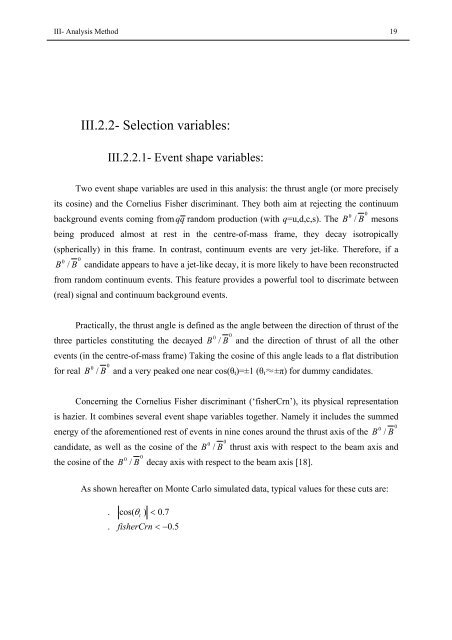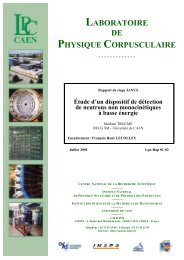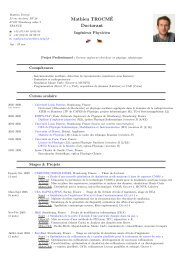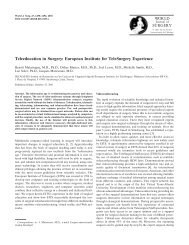Rare B meson decays - mathieu trocmé
Rare B meson decays - mathieu trocmé
Rare B meson decays - mathieu trocmé
Create successful ePaper yourself
Turn your PDF publications into a flip-book with our unique Google optimized e-Paper software.
III- Analysis Method 19<br />
III.2.2- Selection variables:<br />
III.2.2.1- Event shape variables:<br />
Two event shape variables are used in this analysis: the thrust angle (or more precisely<br />
its cosine) and the Cornelius Fisher discriminant. They both aim at rejecting the continuum<br />
0<br />
0<br />
background events coming from qq random production (with q=u,d,c,s). The B / B <strong>meson</strong>s<br />
being produced almost at rest in the centre-of-mass frame, they decay isotropically<br />
(spherically) in this frame. In contrast, continuum events are very jet-like. Therefore, if a<br />
0<br />
0<br />
B / B candidate appears to have a jet-like decay, it is more likely to have been reconstructed<br />
from random continuum events. This feature provides a powerful tool to discrimate between<br />
(real) signal and continuum background events.<br />
Practically, the thrust angle is defined as the angle between the direction of thrust of the<br />
0<br />
0<br />
three particles constituting the decayed B / B and the direction of thrust of all the other<br />
events (in the centre-of-mass frame) Taking the cosine of this angle leads to a flat distribution<br />
0<br />
0<br />
for real B / B and a very peaked one near cos(θt)=±1 (θt≈±π) for dummy candidates.<br />
Concerning the Cornelius Fisher discriminant (‘fisherCrn’), its physical representation<br />
is hazier. It combines several event shape variables together. Namely it includes the summed<br />
0<br />
0<br />
energy of the aforementioned rest of events in nine cones around the thrust axis of the B / B<br />
0<br />
0<br />
candidate, as well as the cosine of the B / B thrust axis with respect to the beam axis and<br />
0<br />
0<br />
the cosine of the B / B decay axis with respect to the beam axis [18].<br />
As shown hereafter on Monte Carlo simulated data, typical values for these cuts are:<br />
. cos( θ t ) < 0.<br />
7<br />
. fisherCrn<br />
< −0.<br />
5






